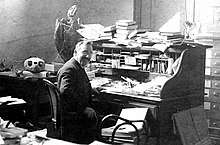Oliver Perry Hay
Oliver Perry Hay (May 22, 1846 – November 2, 1930) was an American herpetologist, ichthyologist, and paleontologist.
Oliver Perry Hay | |
|---|---|
 Hay at his desk at the Carnegie Institution, circa 1920 | |
| Born | May 22, 1846 |
| Died | November 2, 1930 (aged 84) |
| Nationality | American |
| Scientific career | |
| Fields | |
| Institutions | Carnegie Institution for Science |
Hay was born in Jefferson County, Indiana, to Robert and Margaret Hay. In 1870, Hay graduated with a Bachelor of Arts from Eureka College in Illinois. He taught at the college as a sciences professor from 1870–1873.[1] He married Mary E. Howsmon of Eureka, Illinois in 1870. He was a professor at Oskaloosa College in Iowa from 1874–1876. He was a student at Yale University from 1876–1877. Seventeen years after earning his Bachelors, he earned his PhD from Indiana University in Bloomington, Indiana. From 1877–1879 he taught at Abingdon College just before it was incorporated into his alma mater, Eureka College. His longest professorship was at Butler University from 1879–1892. From 1894 to 1895 he worked at the Field Museum of Natural History as assistant curator of zoology where, despite his speciality in ichthyology, he worked in all non-ornithological fields of zoology. In 1912, Hay was appointed as a research associate at the Carnegie Institution for Science, and was given office space at the United States National Museum. There he did much work with the USNM's collections in vertebrate paleontology. He published extensively on fossil turtles and Pleistocene mammals. The catalogs that he constructed were a great aid in recording existing knowledge and became standard references. His papers from 1911 to 1930 are stored at the Smithsonian Institution.[2]
Oliver and Mary had four children together.[3] Their son, William Perry Hay, was also a zoologist.
Works
Below is a partial list of Hay's work.
- Hay, Oliver Perry (1892). The Batrachians and Reptiles of Indiana. Original from the University of Michigan: Wm. B. Burford. p. 204 Pages.
Oliver Perry Hay.
- Hay, Oliver Perry (1896). Fieldiana Zoology. V.1, No.4. "On some collections of fishes made in the Kankakee and Illinois". Chicago, IL: Field Museum of Natural History. pp. 85–97.
- Hay, Oliver Perry (1902). Bibliography and Catalogue of the Fossil Vertebrata of North America. Bulletin of the United States Geological Survey. 179. Govt. Print. Off. p. 868 pages. OCLC 681072233.
- Hay, Oliver Perry (1923). The Pleistocene of North America and Its Vertebrated Animals from the States East of the Mississippi River and from the Canadian Provinces East of Longitude 95.̊. Carnegie Institution of Washington. p. 499 pages. OCLC 595145229.
- Hay, Oliver Perry (1923). "Characteristics of sundry fossil vertebrates". Pan-American Geologist. 39: 101–120. OCLC 38855496.
References
- Alumni Association, Eureka College (1894). A History of Eureka College with Biographical Sketches and Reminiscences. St. Louis, MO: Christian Publishing Company. p. 173. ISBN 9783337388706.
- Cox, William (February 8, 2006). "Record Unit 7188 Oliver Perry Hay Papers, 1911–1930" (web). Finding Aids to Personal Papers and Special Collections in the Smithsonian Institution Archives. Smithsonian Institution. Retrieved January 14, 2008.
- Lull, Richard Swann (1931). "Memorial of Oliver Perry Hay" (PDF). Bulletin of the Geological Society of America. 42: 30–48.